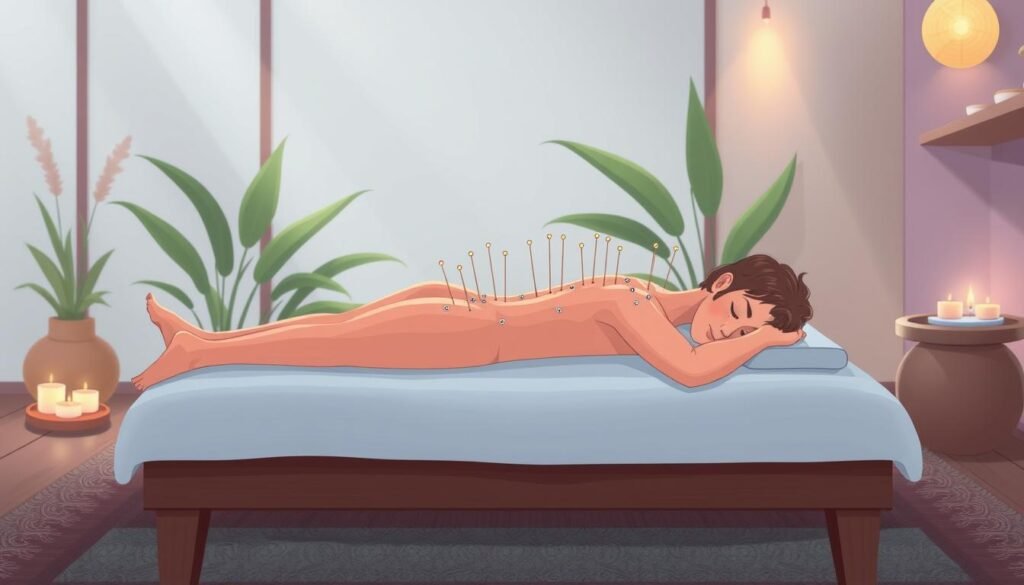Did you know that 38% of adults and 12% of children in the United States use complementary and alternative medicine (CAM)? This shows more people are choosing natural therapies alongside traditional medical treatments. They prefer holistic approaches, using methods like herbal remedies and acupuncture for better health.
This guide explores the diverse world of alternative medicine. It looks at various treatments, from body techniques such as yoga to therapies that connect mind and body. By understanding these, you can better manage your health and make smarter choices.
In this article, we will explore effective ways to maintain health, including herbal remedies and acupuncture. These methods play a key role in supporting mental, physical, and spiritual well-being. Let’s dive into the healing practices that enhance our overall health.
Key Takeaways
- 38% of adults in the U.S. use complementary and alternative medicine.
- Holistic healing focuses on achieving balance and treating the patient as a whole.
- Naturopathy utilizes natural remedies like herbal medicine and acupuncture.
- Various holistic health care providers include naturopathic doctors and osteopaths.
- A holistic approach often combines alternative treatments with conventional medicine.
Introduction to Natural Therapies
Natural therapies focus on mind, body, and spirit as one. They have become popular for offering healing beyond conventional methods. These approaches aim to find and treat the root causes of health issues, not just the symptoms.
People turn to natural therapies for better overall health, stress management, or chronic illness coping. Practices include acupuncture, herbal medicine, and energy healing. They help the body heal itself, aiming for balance and harmony.
It’s important to know about these therapies if you’re looking into alternative healing. Combining them with treatments like radiation therapy can improve emotional health. The move toward holistic health is becoming more known, encouraging people to see how these methods can better their lives.
There’s a variety of natural therapies to match different health aspirations. Research supports the success of many, such as mind-body practices. Adopting a holistic view of health care not only enables personal empowerment but also leads to deep healing.
The Rise of Alternative Medicine
Alternative medicine has been growing, shaping healthcare in new ways. For the last 20 years, more people have turned to holistic health options. They seek care that is tailored to their needs, which they don’t always find in traditional medicine.
In the U.S., 62% of people have tried integrative health therapies for their well-being. Natural therapies, especially herbal remedies, are highly popular. They are chosen for being safe and effective. A study by Barnes et al. shows that these natural products are top choices in the U.S. for health care.
Therapies like deep breathing, yoga, and occupational therapy are becoming more popular. This shows the growing interest in natural healing options. Acupuncture and other regulated therapies are also seeing more use. This indicates that alternative medicine is getting more accepted by health professionals.
Family doctors are now learning more about these methods, as more people use them. The use of complementary health approaches in the U.S. has increased greatly. This shows a big change in how people look after their health. They now focus more on preventing illness and maintaining wellness.
For more information on how these therapies are evolving and integrating, check out the latest research on CAM here.
Understanding Herbal Remedies
Herbs have been used for healing for hundreds of years across different cultures. They come from plants and are loved as safe choices compared to regular medicine. Learning about herbal remedies means seeing their value, benefits, and knowing how to use them right.
What Are Herbal Remedies?
Herbal remedies use parts of plants like leaves, roots, and flowers to help heal. In the U.S., these remedies are seen as food, not medicine. This means they’re not all made the same way, which can be confusing. It’s important to check how reliable the makers are, looking for products that tell you exactly what’s in them and meet quality standards.
Benefits of Using Herbal Remedies
Choosing herbal remedies can be very beneficial. Here’s why:
- Fewer side effects: Many find herbal remedies gentler than synthetic drugs.
- Targeted treatments: Certain herbs help with specific issues, like stomach troubles or pain.
- Integration into daily life: It’s easy to include herbs in your routine for better health.
- Complementary support: Some herbs can make traditional treatments work better and ease symptoms.
Even though herbal remedies have perks, it’s important to be careful about mixing them with other medicines. Always talk to a doctor before beginning an herbal remedy. Herbs can be a great part of taking care of your health as a whole.
Acupuncture: An Overview
Acupuncture is a key part of traditional Chinese medicine, dating back to 200 BCE. It uses fine needles inserted into the body to improve balance and aid healing. By doing so, it helps the body release chemicals that boost well-being.
There are many benefits of acupuncture. It helps with a variety of conditions, such as:
- Chronic pain (e.g., arthritis, lower back pain)
- Headaches and migraines
- Nausea and vomiting from chemotherapy or surgery
- Musculoskeletal disorders
- Emotional concerns, such as anxiety
Acupuncture helps by balancing Qi, the body’s vital energy. This balance is key for overall health. It can help with everything from stomach problems to breathing issues.
Before you try acupuncture, talk to your doctor, especially if you are pregnant or have certain infections. Make sure your acupuncturist is licensed. Training and certification can be different in each state.
Some people feel better right after acupuncture. Others might need 6 to 8 sessions for the best results. Each session can be up to an hour long and involve 5 to 20 needles.

| Condition Treated | Acupuncture Benefit |
|---|---|
| Chronic Pain | Pain relief |
| Nausea | Reduction of symptoms |
| Headaches | Relief from tension |
| Emotional Issues | Improved mood stability |
| Respiratory Disorders | Enhanced breathing |
Acupuncture has become popular in the U.S., with the National Institutes of Health endorsing it in 1997. Its use in modern wellness shows the lasting value of traditional Chinese medicine in today’s health care.
Holistic Healing: Connecting Mind and Body
Holistic healing views the mind and body as deeply connected. It believes our emotions, physical state, and spirit all play parts in our health. Techniques like meditation, yoga, and acupuncture tap into this connection to help us heal. There are over a hundred holistic healing methods today, always growing and adding to the ways we can get better.
These methods fall into five main types. There are alternative medical systems, mind-body interventions, and therapies based on biology. There’s also manipulative methods and energy therapies. Each offers special ways to improve our health and is easy to get into.
Eating poorly, not getting enough sleep, or skipping exercise can hurt our health. These factors show the importance of our lifestyle in keeping our mind and body in sync. The gut-brain axis, for example, shows how our gut health affects our mood and thoughts. Also, having friends and family support us can lower stress and make us happier, showing how everything about our health is linked.
Being in nature can make us feel mentally and physically better. This ties back to the “Health Hexagon Model,” which talks about diet, sleep, exercise, nature, and social life. Combining regular medical treatments with holistic approaches leads to better health. This shows just how critical the mind-body connection is.
| Holistic Healing Categories | Description |
|---|---|
| Alternative Medical Systems | These are complete systems like Traditional Chinese Medicine and Ayurveda. They have their own ways of understanding health and how to treat it. |
| Mind-Body Interventions | Methods like meditation and yoga that boost our mental and physical well-being at the same time. |
| Biologically-Based Therapies | These use natural elements like herbs and supplements to help our bodies heal. |
| Manipulative and Body-Based Methods | Therapies such as chiropractic care and massage that work by adjusting the body’s structure. |
| Energy Therapies | Techniques like Reiki and Qigong that aim to balance the body’s energy fields to improve health. |
Herbal Remedies, Acupuncture, and Other Natural Therapies
Mixing natural therapies like herbal remedies and acupuncture can help us feel better. These treatments together can lead to improved health. They work together, taking care of our body and mind.
Combining Techniques for Better Results
Using different remedies lets each person find what works best for them. Here’s how to mix these treatments:
- Consult professionals: Talking to experts makes sure these treatments are safe and effective.
- Monitor health progress: Watching your health helps find what works best.
- Educate oneself: Learning about these treatments helps in making good choices.
- Be mindful of potential risks: It’s important to be cautious as some herbal remedies might cause side effects.
Check out this table comparing natural therapies and their benefits:
| Therapy | Benefits | Common Uses |
|---|---|---|
| Herbal Remedies | Treats various ailments; supports immune function | Allergies, chronic fatigue, PMS |
| Acupuncture | Reduces pain; alleviates anxiety and depression | Neck and back pain, insomnia, infertility |
| Chiropractic Care | Improves joint function; alleviates headaches | Low back pain, neck pain, whiplash |
| Ayurveda | Promotes balance; utilizes herbs and diet | Overall health; chronic conditions |
| Magnetic Field Therapy | Reduces pain; enhances healing | Osteoarthritis, fractures |

Using different techniques makes us healthier and more involved in our care. By learning and using various treatments, we can live a happier and healthier life.
Benefits of Naturopathy
Naturopathy uses the body’s healing powers through different techniques. It aims to tackle the root causes of diseases. This way, it promotes total health by combining natural remedies, changes in lifestyle, and diet plans made just for you.
Key Naturopathic Techniques
There are several naturopathic methods used to help heal the body. These strategies are especially good for long-lasting health issues that don’t get better with usual treatments.
- Nutrition Therapy: This makes personalized eating plans to boost health. It tackles problems like overweight, diabetes, and stomach issues.
- Homeopathy: It uses very diluted substances to kickstart healing. This aims to help with both body and mind issues.
- Botanical Medicine: By using herbs, this approach helps with various problems. For example, it can reduce swelling or ease anxiety.
Naturopathic methods offer more than quick fixes. They aim for lasting health gains, helping you live a fuller, healthier life. Studies show these approaches can effectively handle long-term issues, like heart disease and diabetes type 2.
| Condition | Naturopathic Approach | Evidence of Effectiveness |
|---|---|---|
| Type 2 Diabetes | Meal planning, herbal supplements | Small studies show good results |
| Cardiovascular Disease | Lifestyle changes, botanical treatments | 2019 review sees potential benefits |
| Chronic Pain | Herbal medicine, acupuncture | Certain herbs work better than fake treatments |
| Emotional Disorders | Counseling, homeopathy | Whole-person treatment methods |
Naturopathy focuses on you as a whole person. It offers various ways to heal naturally. Its goal is to give you control over your health by fostering well-being, eco-friendliness, and balance in your life.
Exploring Homeopathy
Homeopathy is a unique type of alternative medicine that focuses on personalized treatment. It uses the idea of treating similar issues with similar substances. These substances come from nature and are highly diluted. This method is closely linked to natural healing, highlighting the body’s power to heal itself.
Principles of Homeopathy
Homeopathy is based on several important principles:
- Individualization: Treatments are customized for each person. Practitioners carefully choose remedies after assessing a patient’s specific symptoms and health issues.
- Microdosing: Remedies are made by diluting substances many times. This process may leave no original molecules. It’s thought this makes the remedy more effective by stimulating the body’s healing processes.
- Holistic Approach: Homeopathy looks at a person’s overall health, including their emotions and mind. This helps heal the whole person, not just physical symptoms.
Homeopathy has been effective against a range of issues. It works on allergies, colds, asthma, and even depression. More and more people are turning to it because it’s safe. It poses little risk, so anyone can use it, including babies, pregnant women, and pets. Homeopathy is a natural choice for those wanting an alternative to regular medicine.

Complementary Therapies: Enhancing Your Well-Being
Complementary therapies like aromatherapy, massage, and yoga can greatly improve wellness. They work well with regular medical care, offering a full health approach. The evidence from studies shows how helpful they can be, even if more research is needed.
Many people dealing with anxiety or chronic pain find relief with acupuncture and yoga. These practices help you relax and manage stress. Yoga, for example, boosts your stress-handling abilities and emotional control by activating the calm part of your nervous system.
Even with limited research, adding these therapies to your health routine can be very supportive. Activities such as exercise, exposure to bright light, and taking omega-3s are showing positive effects. Knowing the options can help you make better health choices.
A lot of cancer patients are trying complementary therapies along with their usual medical treatments. More than half of these patients look for physical and emotional support this way. Techniques like art therapy and tai chi are especially good at lowering stress and enhancing life quality.
Talking openly with your doctor about trying complementary therapies is crucial. While some doctors might be cautious, understanding their benefits can lead to teamwork in your care. As more people choose these therapies, our approach to health is changing for the better.
| Complementary Therapies | Key Benefits | Commonly Used In |
|---|---|---|
| Aromatherapy | Reduces stress and anxiety | Cancer treatment |
| Yoga | Enhances stress tolerance | Various health conditions |
| Acupuncture | Improves pain relief | Physical and mental health |
| Art Therapy | Encourages emotional expression | Cancer care |
| Tai Chi | Enhances overall quality of life | Chronic illness management |
Conclusion
Herbal remedies, acupuncture, and other natural therapies are key for complete health. They help people take control of their health, making smart choices for their wellness. These practices have been valuable in cultures around the world for over 5,000 years.
Using foods as medicine, a concept from ancient Ayurveda, is still popular today. People are turning to natural solutions for their health problems. But it’s important to know that products like turmeric and ginger aren’t strictly regulated by the FDA. They don’t undergo thorough safety checks.
Interest in alternative medicine is growing, as shown by its increase from 34% to 42% between 1990 and 1997. Consumers need to be informed about these treatments. For those interested in learning more about herbal medicine, please explore this study.
Adopting a variety of natural therapies can enhance life quality and promote balance. By exploring options like acupuncture and herbs, people can empower themselves health-wise. This holistic view fosters a stronger connection with one’s health, improving both mental and physical states.